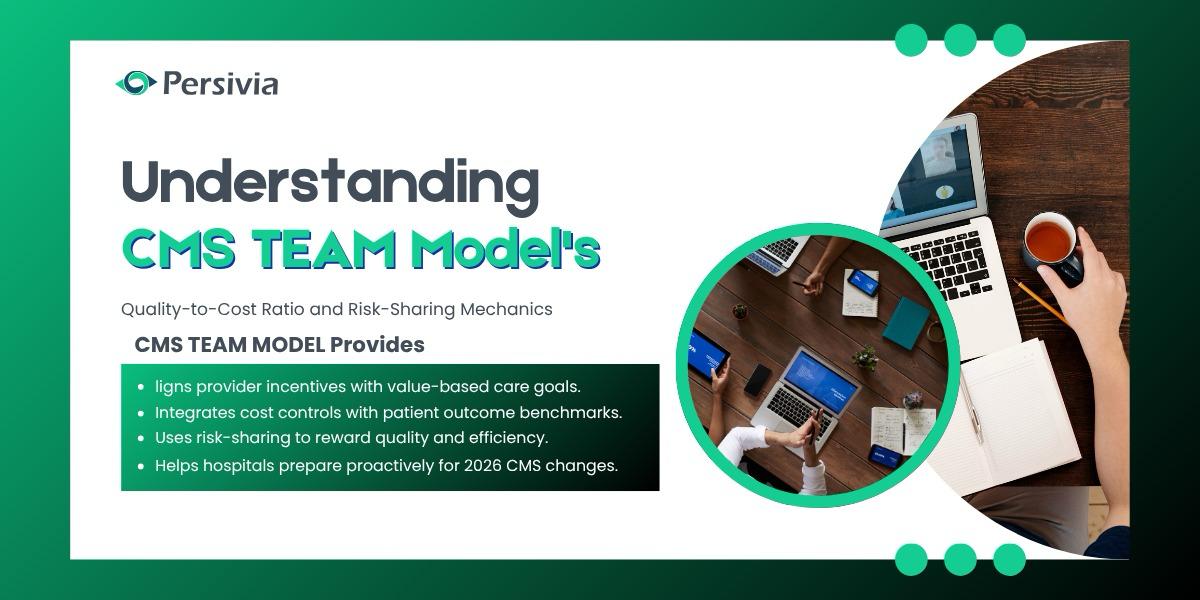The healthcare landscape faces its biggest transformation since the introduction of DRGs. The CMS TEAM Model launches January 1, 2026, fundamentally changing how hospitals approach episode-based care. This mandatory payment model shifts financial risk directly to hospitals while demanding measurable quality improvements. Unlike previous voluntary bundled payment programs, the TEAM Model CMS creates a direct quality-to-cost equation that hospitals cannot ignore. Understanding these mechanics becomes critical for financial survival and operational success in the new Medicare payment environment.
What is the CMS TEAM Model and How Does It Work?
The Transforming Episodic Accountability Model TEAM holds hospitals financially responsible for 30-day care episodes spanning five surgical procedures: lower extremity joint replacements, spinal fusions, coronary artery bypass grafts, surgical hip/femur fracture treatments, and major bowel procedures.
The model operates through target pricing. CMS calculates benchmark prices using three-year baseline data, then applies risk adjustments and discount factors. Hospitals spending below targets receive additional payments. Those exceeding targets face recoupments.
The Medicare TEAM Model covers approximately 25% of Core Based Statistical Areas nationwide. Participation is mandatory for acute care hospitals in selected regions, affecting thousands of facilities across the United States.
How Does the Quality-to-Cost Ratio Function in TEAM?
The quality-to-cost ratio directly impacts financial reconciliation through the Composite Quality Score (CQS). Higher quality performance increases shared savings by up to 10% while reducing shared losses by up to 15%.
The TEAM Model uses four primary quality measures:
- Hybrid All-Cause Readmission Measure: Tracks 30-day readmissions across all causes
- CMS Patient Safety Indicator 90: Monitors hospital-acquired conditions and safety events
- Lower Extremity Joint Replacement Patient-Reported Outcomes: Measures functional improvement from the patient perspective
- Hospital Harm and Failure to Rescue Measures: Evaluates preventable complications (starting Performance Year 2)
These measures combine into a single CQS score weighted by episode volume. The score multiplies against financial reconciliation amounts, creating direct monetary incentives for quality improvement.
What Are the Risk-Sharing Mechanics?
Risk-sharing in the TEAM Model CMS operates through upside and downside financial exposure. Hospitals share in both savings and losses based on their performance against target prices.
Upside Risk (Shared Savings):
- Hospitals receive 50% of savings when spending falls below target prices
- Quality performance can increase this percentage up to 55%
- Maximum shared savings capped at specific thresholds
Downside Risk (Shared Losses):
- Hospitals pay 50% of the excess costs when spending exceeds targets
- Quality performance can reduce this percentage to 42.5%
- Maximum shared losses capped to protect hospital financial stability
The model includes stop-loss protections and discount factors that vary by episode type. LEJR, SHFFT, and Spinal Fusion episodes carry 2.0% discounts, while CABG and Major Bowel procedures have 1.5% discounts.
How Are Target Prices Calculated?
Target price calculation starts with regional benchmark data for each MS-DRG/HCPCS episode type. The baseline uses three-year weighted averages that roll forward annually.
Risk Adjustment Factors:
- Age brackets based on episode start date
- Hierarchical Condition Category (HCC) counts from 90-day lookback periods
- Social risk factors, including dual eligibility and area deprivation indices
- Hospital characteristics like bed size and safety net status
The methodology mirrors successful models like CJR and BPCI Advanced. Multipliers remain fixed at reconciliation, allowing hospitals to estimate final target prices proactively.
Site-neutral adjustments apply to specific episode types where post-acute care settings show equivalent outcomes. This encourages appropriate care transitions and reduces unnecessary institutional care.
What Quality Measures Drive Financial Performance?
Quality measurement in the TEAM Model focuses on outcomes hospitals can directly influence during 30-day episodes.
- Readmission Prevention becomes financially critical. Each prevented readmission saves hospitals money while improving quality scores. The hybrid measurement approach combines claims data with chart reviews for accuracy.
- Patient Safety Indicators track hospital-acquired conditions, surgical complications, and preventable adverse events. Hospitals with strong safety records receive quality bonuses during reconciliation.
- Patient-reported outcomes for joint replacements measure functional improvement and pain reduction. This patient-centered approach aligns financial incentives with recovery goals.
- Care Coordination Metrics evaluate transitions between care settings. Smooth handoffs reduce complications and improve episode outcomes.
How Does Risk Adjustment Impact Hospital Performance?
Risk adjustment ensures fair comparisons across diverse patient populations. The Medicare TEAM Model uses sophisticated methodology to account for patient complexity and hospital characteristics.
Patient-Level Adjustments:
- Age categories affect baseline risk scores
- HCC counts from diagnosis histories influence target prices
- Social determinants, including income and geographic factors
Hospital-Level Adjustments:
- Bed size correlates with case complexity and resource availability
- Safety net status recognizes hospitals serving vulnerable populations
- Teaching status and other institutional factors
The adjustment methodology prevents hospitals from avoiding complex cases while ensuring appropriate payment for higher-risk patients. Multipliers are calculated during baseline periods and remain transparent to participants.
Financial Importance for Hospitals
Financial exposure varies significantly based on episode volume and performance. Large hospitals with high episode volumes face substantial upside and downside risk.
Revenue Impact Analysis:
- Hospitals performing 200+ episodes annually face millions in potential gains or losses
- Quality performance can swing financial outcomes by 25% or more
- Post-acute care optimization becomes critical for financial success
Cost Management Strategies:
- Discharge planning directly impacts episode costs
- Therapy services transform from cost centers to revenue generators
- Care coordination reduces expensive complications and readmissions
Capital Investment Requirements:
- Data analytics platforms become essential for performance tracking
- Care management systems need integration across episode timelines
- Quality improvement programs require dedicated resources
How Can Hospitals Prepare for TEAM Implementation?
Preparation requires a systematic assessment of current performance and strategic planning for episode management.
Data Infrastructure Development:
- Implement episode tracking systems across 30-day timelines
- Integrate clinical and financial data for real-time performance monitoring
- Establish benchmarking capabilities against target prices
Care Pathway Optimization:
- Develop evidence-based protocols for each episode type
- Create discharge planning processes focused on appropriate care transitions
- Implement early mobility programs to reduce post-acute care needs
Quality Improvement Initiatives:
- Target specific quality measures that impact financial reconciliation
- Establish patient safety protocols to prevent hospital-acquired conditions
- Develop patient-reported outcome tracking systems
Provider Network Management:
- Evaluate post-acute care partners for quality and cost performance
- Establish preferred provider agreements with high-performing facilities
- Create communication systems for seamless care transitions
Technology Solutions That Support TEAM Success
Technology platforms become essential for managing episode-based care and financial risk. Hospitals need integrated systems that track performance across multiple dimensions.
Analytics Capabilities:
- Real-time episode cost tracking against target prices
- Quality metric monitoring with automated alerts
- Predictive modeling for discharge planning optimization
Care Coordination Tools:
- Patient tracking across care settings during 30-day episodes
- Communication platforms connecting all episode participants
- Workflow management for care transitions
Financial Management Systems:
- Reconciliation calculation and projection tools
- Risk adjustment monitoring and validation
- Performance reporting for administrative oversight
Advanced platforms like Persivia’s CareSpace® integrate these capabilities into comprehensive episode management solutions. The platform provides AI-driven analytics, care coordination workflows, and financial performance tracking specifically designed for episodic payment models.
Final Call
The CMS TEAM Model represents healthcare’s most significant payment transformation in decades. Success requires understanding the intricate balance between quality metrics and cost management while navigating complex risk-sharing mechanics.
Hospitals must prepare now for the January 2026 implementation. The quality-to-cost ratio creates direct financial incentives for improved care coordination, patient safety, and outcome optimization. Those who master these mechanics will thrive in the new payment environment.
Ready to Transform Your Hospital’s Episode Performance?
Persivia CareSpace® platform has already helped hospitals like Prime Healthcare achieve $17 million in savings with 15% readmission reductions. Our AI-driven analytics and integrated care coordination tools are specifically designed for episode-based payment models like TEAM.
Don’t wait until 2026 to start preparing. From real-time episode tracking to quality metric optimization and financial performance management, our comprehensive platform provides everything you need to succeed in the new Medicare payment landscape.
Learn More About Our TEAM Solutions and see how leading hospitals are already preparing for the future of episode-based care.
Schedule A Consultation Today!

